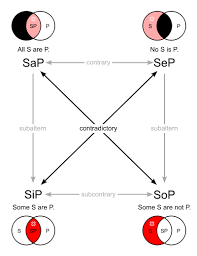
Square of opposition is a good introduction to logic. Understanding square of opposition will improve our logical thinking.
At the four corners of the square are the four types of statements. In clock wise direction, starting from the top left, they are denoted as A, E, O, and I.
Type A: All S are P or Every S is P (Also known as Universal Affirmative)
Type E: No S is P ( Universal Negative)
Type I: Some S are P ( Particular Affirmative)
Type O: Some S are not P ( Particular Negative)
Square of opposition states that statements A and E are contrary. When one statement is true, the other cannot be true. There is also a possibility that both can be false. For example, if some S are P, then both the statements A and E are false. Similarly, if some S are not P, then both the statements A and E are false.
The two pairs of statements (A, O) and (E, I) are contradictory. This is similar to contrary statements in that when one statement is true, the other cannot be true. However, the missing part is that the possibility of both can be false.
The statements I and O are sub contrary. They both cannot be false. For example, if all S are P, then only type O is false. Similarly, if no S are P, then only type I is false.
The two pairs of statements (A, I) and (E, O) are subaltern. When A is true, I is also true. When E is true, O is also true. The logic is when something is true for the whole part, you can definitely say it is true for its sub set.
Published by mathivananpalraj
Mathivanan Palraj works at Fastrac Center for Competitive Studies (Self employed), Ernakulam, Kerala, South India. He did his Bachelor of Science (Mathematics) at Madurai-Kamaraj University. He worked in a public sector bank for some time as an officer and then got through civil services exam. At Fastrac, he prepares students for various jobs and admission tests. On Sundays, he goes to a community center to teach study skills for schoolchildren. He strongly believes that he can improve a person’s intelligence through his ‘smartbrains’ program. He is doing a research to find out whether this can be achieved through simple arithmetic, logical, and verbal tests. His research shows positive results.
His teaching profession began in 2000 after a stint in a public sector bank and in government. After setting up Fastrac, he also took up a part-time faculty position at the Institute of Management Studies (IMS), Kochi and thereafter at T.I.M.E., Kochi. He has been teaching problem solving, data sufficiency and verbal reasoning to students for various management admission tests.
Encouraged by students and peers, he began writing a book on problem solving techniques. The book took shape in 2010 and finally published in 2015 in Amazon Kindle: GMAT, Problem Solving Techniques for Top-Score. His second book, GMAT: Problem Solving Techniques-II, 101 Selected Problems for Top Score, has also been published in Amazon KDP.
He also writes articles and publishes in Ezinearticles (Mathivanan+expert). You can also view his articles in his blogs: 1) views2life.blogspot.in 2) focus2india.blogspot.in.
View all posts by mathivananpalraj
